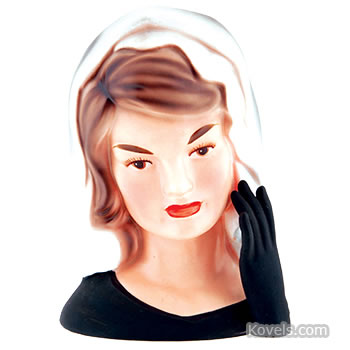Collectors often jump into a new collection because publicity has created a fad. Metal lunch boxes, cookie jars, plastic purses, Avon bottles and lady head vases all had a time when collectors owned and displayed several hundred examples. In 2015, it’s a problem when the head vases in grandma’s attic are worth less than their original cost and are not easy to sell.
Lady head vases were originally made to hold florists’ flower arrangements. A few were made by American factories in the 1930s, but collectors didn’t start gathering huge collections until the 1950s. The fad cooled down by the 1970s. In the 1950s, early lady heads, also called head vases or head planters, sold for a dollar or so at flea markets and garage sales. Most were made in the United States by small manufactures, including Betty Lou Nichols Ceramics, Florence Ceramics, Ceramic Arts Studio and Royal Copley. Almost all head vases were marked with the maker’s name. At the end of World War II, Asian manufacturers began to compete with those in the United States and made copies of lady heads that sold for a lower price. Importers started to sell the Chinese and Japanese products with the American importer’s name or a store name. Enesco, Lefton China, Napco and Ucagco are the best known. But some were marked only with a paper label that has been removed and those are the reproductions that may be offered today.
Lady heads with hats, costume jewelry earrings and necklaces, an added arm and hand, raised ruffles and flowers, thick 3-D eyelashes and other raised features brought, and still bring, the highest prices. Also wanted are lady heads that look like stars such as Jackie Kennedy, Lucille Ball or Carmen Miranda. Most of the vases picture attractive women or cute children, but a few strange examples like a green Chinese man, a clown or a very young baby can be found.
The bad news is it’s difficult to recognize unlabeled head vases as late copies. There is a big difference in quality so look for crisp molding, carefully painted details, and perhaps added 3-D features. Some early California vases are made of heavy pottery while most repros are of a lighter weight porcelain. Most old examples in perfect condition sell for up to $150 now. Reproductions are easy to find for under $10.




Leave a Reply
You must be logged in to post a comment.